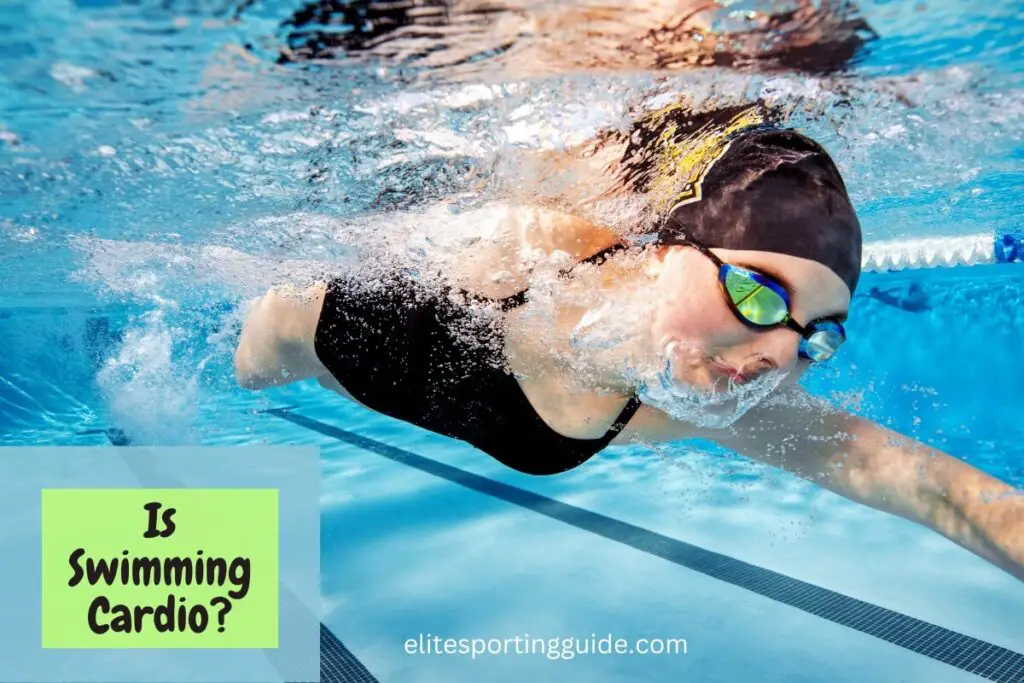In this comprehensive exploration, we explore the physiological aspects of swimming, its impact on heart health, and how it compares to other forms of cardio workouts.
By the end of this article, you will have a clear understanding of the role swimming plays in enhancing cardiovascular fitness and its overall contributions to a well-rounded exercise regimen.
Is Swimming Cardio?
Yes, swimming is considered a cardiovascular exercise. It engages multiple muscle groups and raises your heart rate, making it an effective way to improve cardiovascular fitness and overall endurance.
The Cardiovascular Benefits of Swimming

Swimming offers a wide range of cardiovascular benefits, making it an excellent choice for improving heart health and overall fitness. Some of the key cardiovascular benefits of swimming include:
1. Improved Heart Health: Swimming is an aerobic exercise that elevates your heart rate, helping to strengthen the heart muscle and improve its efficiency in pumping blood.
2. Increased Circulation: Swimming enhances blood flow throughout the body, which can lead to better circulation and a reduced risk of cardiovascular diseases like hypertension and atherosclerosis.
3. Lower Blood Pressure: Regular swimming can help lower blood pressure, reducing the strain on the heart and decreasing the risk of stroke and heart disease.
4. Enhanced Lung Capacity: Swimming requires controlled breathing techniques, which can lead to improved lung capacity and better oxygen exchange in the body.
5. Weight Management: Swimming is a full-body workout that burns a significant number of calories, making it an effective way to manage weight and reduce the risk of obesity-related heart issues.
6. Reduced Cholesterol Levels: Swimming can help raise HDL (good) cholesterol and lower LDL (bad) cholesterol levels, contributing to a healthier lipid profile.
7. Stress Reduction: Engaging in regular swimming can help reduce stress and anxiety, which, in turn, benefits heart health by lowering the risk of stress-related cardiovascular problems.
8. Enhanced Endurance: Swimming builds cardiovascular endurance, enabling the heart to work efficiently during prolonged physical activity.
9. Better Blood Sugar Control: For individuals with diabetes, swimming can help regulate blood sugar levels, reducing the risk of diabetic heart complications.
10. Low-Impact Exercise: Swimming is gentle on the joints, making it an excellent choice for people with joint issues or those recovering from injuries, as it provides a cardiovascular workout without the impact associated with activities like running.
11. Whole-Body Workout: Swimming engages multiple muscle groups, promoting overall fitness and toning of the body, which can indirectly benefit cardiovascular health.
12. Longevity: Studies have suggested that regular swimmers may enjoy a longer lifespan due to the combined effects of improved heart health, reduced stress, and enhanced fitness..
Understanding Cardiovascular Exercise
Understanding cardiovascular exercise, often referred to as cardio or aerobic exercise, is essential for anyone looking to improve their overall fitness and heart health.
Cardiovascular exercise is a form of physical activity that increases your heart rate and breathing rate, promoting the circulation of oxygenated blood throughout your body.
Here’s a deeper look at the key aspects of cardiovascular exercise:
1. Heart Health: Cardiovascular exercise primarily targets your heart, making it stronger and more efficient.
As you engage in activities that elevate your heart rate, your heart pumps more blood with each beat, reducing the effort required for it to perform its functions over time.
2. Aerobic Metabolism: Cardio workouts rely on aerobic metabolism, which means your body uses oxygen to produce energy.
This process helps burn calories and fat, making cardio exercises effective for weight management.
3. Types of Cardio Exercises: Cardiovascular exercise encompasses a wide range of activities, including running, cycling, swimming, dancing, brisk walking, and more.
These activities can be performed at various intensities, making cardio workouts accessible to people of different fitness levels.
4. Benefits: Regular cardiovascular exercise offers numerous benefits, including improved lung capacity, better circulation, increased endurance, reduced risk of heart disease, lower blood pressure, and improved cholesterol levels.
It can also enhance mood, reduce stress, and boost overall mental well-being.
5. Frequency and Duration: The American Heart Association recommends at least 150 minutes of moderate-intensity cardio exercise or 75 minutes of vigorous-intensity exercise per week, ideally spread across several days.
This guideline helps maintain good heart health.
6. Intensity: Cardio workouts can be classified as low, moderate, or high-intensity.
Low-intensity activities like walking are less demanding on the body, while high-intensity exercises like sprinting or interval training push your cardiovascular system to its limits.
7. Target Heart Rate: To ensure you’re working within a beneficial range, it’s helpful to calculate and monitor your target heart rate during cardio exercises.
This zone is typically 50-85% of your maximum heart rate and varies depending on your age and fitness level.
8. Warm-up and Cool-down: It’s vital to begin each cardio session with a warm-up to prepare your body and gradually increase your heart rate.
Likewise, cooling down with stretching and slower-paced exercises helps your heart rate return to its resting state safely.
9. Variety: Mixing different cardio activities into your routine can prevent boredom and work various muscle groups, contributing to a more well-rounded fitness program.
10. Safety Considerations: Safety is paramount when engaging in cardiovascular exercise. It’s essential to use proper form, wear appropriate gear, stay hydrated, and listen to your body.
Swimming and Heart Health
Swimming is an excellent exercise for promoting heart health and overall cardiovascular fitness.
Here’s how swimming contributes to heart health:
1. Aerobic Exercise: Swimming is a highly effective form of aerobic exercise. It increases your heart rate and breathing rate, which strengthens your heart muscle over time.
This increased demand on the heart leads to improved cardiovascular fitness.
2. Lower Blood Pressure: Swimming regularly can help lower blood pressure.
The combination of aerobic activity, controlled breathing, and buoyancy in the water contributes to reduced hypertension, decreasing the risk of heart disease and stroke.
3. Improved Cholesterol Levels: Swimming can raise levels of HDL (good) cholesterol and lower levels of LDL (bad) cholesterol.
This beneficial impact on your lipid profile can reduce the risk of arterial plaque buildup, which is associated with heart disease.
4. Enhanced Blood Circulation: Swimming promotes better circulation by increasing blood flow to various muscle groups.
This improved circulation helps oxygenate tissues and organs, reducing the risk of blood clots and related heart problems.
5. Heart Efficiency: Swimming increases stroke volume, which is the amount of blood the heart pumps with each beat.
As the heart becomes more efficient at pumping blood, it can maintain a lower resting heart rate, reducing the overall workload on the heart.
6. Weight Management: Swimming is a calorie-burning exercise that can assist in weight management.
Maintaining a healthy weight is essential for heart health, as it reduces the risk of obesity-related cardiovascular issues.
7. Stress Reduction: Engaging in swimming can have a calming and stress-reducing effect.
Stress is a known contributor to heart problems, so managing stress through activities like swimming can be beneficial for heart health.
8. Lung Capacity: Swimming requires controlled breathing, which can enhance lung capacity and respiratory efficiency.
This helps in supplying oxygen to the bloodstream and reduces the strain on the heart.
9. Longevity: Studies have shown that regular swimmers tend to have longer lifespans.
This can be attributed to the combined benefits of improved heart health, reduced stress, and overall physical fitness that swimming offers.
10. Safety and Low Impact: Swimming is a low-impact exercise that is gentle on the joints.
This makes it an excellent option for individuals of all ages and fitness levels, including those who may have joint issues or injuries.
Comparing Swimming to Traditional Cardio Workouts
Comparing swimming to traditional cardio workouts, such as running, cycling, or brisk walking, reveals distinct advantages and considerations for each form of exercise. Here’s a comparative overview:
1. Impact on Joints and Injury Risk:
•Swimming: Swimming is a low-impact exercise because the buoyancy of the water supports your body weight, reducing stress on joints. This makes it an excellent choice for individuals with joint issues or those recovering from injuries.
•Running/Cycling/Walking: These activities are higher impact and can put more strain on the joints, particularly if proper form and footwear are not maintained. However, they may help build bone density due to their weight-bearing nature.
2. Calorie Burn:
•Swimming: Swimming burns a significant number of calories, making it an effective choice for weight management and cardiovascular fitness. The calorie burn can vary depending on the intensity and stroke used.
•Running/Cycling/Walking: These activities also burn calories effectively. Running at higher intensities tends to burn calories quickly, but cycling and brisk walking are sustainable options for longer durations.
3. Cardiovascular Benefits:
•Swimming: Swimming is an excellent cardiovascular exercise that elevates heart rate and promotes heart health. It engages the upper and lower body simultaneously, increasing circulation and lung capacity.
•Running/Cycling/Walking: These activities are classic forms of cardiovascular exercise and offer similar benefits. They can improve heart health, endurance, and lung function.
4. Muscle Engagement:
•Swimming: Swimming engages a wide range of muscle groups, including the shoulders, back, core, and legs, providing a full-body workout. The resistance of the water helps build lean muscle.
•Running/Cycling/Walking: While these activities primarily work the lower body muscles (legs and glutes), they involve fewer upper body muscles compared to swimming.
5. Variety and Cross-Training:
•Swimming: Swimming offers various strokes and drills, allowing for variety in workouts. It’s a good option for cross-training, which can help prevent overuse injuries.
•Running/Cycling/Walking: These activities can also be varied by changing routes, terrain, or intensity. Cross-training can involve activities like strength training or yoga to balance the exercise routine.
6. Accessibility:
•Swimming: Access to a pool is necessary for swimming, which may not be as readily available as outdoor spaces for running, cycling, or walking.
•Running/Cycling/Walking: These activities can typically be done outdoors, making them more accessible to a broader range of individuals.
7. Mental Benefits:
•Swimming: The water’s calming effect can provide stress relief, and the rhythmic nature of swimming can be meditative.
•Running/Cycling/Walking: These activities also offer mental benefits, such as stress reduction and improved mood.
In conclusion, both swimming and traditional cardio workouts have their unique advantages.
The choice between them often depends on individual preferences, physical condition, and accessibility to facilities.
Some individuals even incorporate a combination of swimming and other forms of cardio to enjoy the benefits of both. Ultimately, the most effective exercise routine is one that you enjoy and can maintain consistently over time.
Post you may like: Is Swimming A Good Exercise?
Swimming Techniques for Cardiovascular Fitness
Swimming is an excellent choice for improving cardiovascular fitness, and mastering certain techniques can help you maximize its benefits. Here are some swimming techniques to enhance your cardiovascular workout:
1. Choose the Right Stroke:
• Freestyle (Front Crawl): Freestyle is one of the most efficient strokes for cardiovascular exercise. It engages the entire body and allows for continuous, rhythmic breathing.
• Butterfly: Butterfly is a demanding stroke that requires a lot of energy and engages the core and upper body muscles. It’s excellent for a high-intensity cardiovascular workout.
• Backstroke: Backstroke provides a good cardiovascular workout and helps balance out the muscle engagement from freestyle. It also allows you to breathe freely while swimming.
• Breaststroke: While breaststroke is a slower stroke, it can still contribute to cardiovascular fitness. Focus on maintaining a steady pace and optimizing your technique.
2. Interval Training:
• Incorporate interval training into your swim sessions to boost cardiovascular fitness. Alternate between short bursts of high-intensity swimming and periods of lower intensity or rest.
For example, swim fast for one lap and then swim slowly for two laps. Repeat this pattern.
3. Breathing Techniques:
• Proper breathing is crucial for cardiovascular fitness during swimming. Try bilateral breathing (breathing on both sides) to improve lung capacity and balance your stroke.
• For advanced swimmers, practice “hypoxic” training by gradually increasing the number of strokes between breaths. This can enhance lung capacity and make your cardiovascular system more efficient.
4. Rhythmic Stroke:
• Maintain a steady and rhythmic stroke to keep your heart rate elevated consistently throughout your swim. Avoid long pauses or extended rest periods between laps.
5. Kick and Pull Sets:
• Incorporate kick and pull sets into your swim workouts. This involves using a kickboard for focused kicking sets and paddles or hand buoys for pull sets.
These exercises isolate the legs and upper body, respectively, intensifying the workout.
6. Use Fins or Paddles:
• Adding swim fins or hand paddles to your swim routine can increase resistance and make your strokes more challenging. This can help you build cardiovascular endurance faster.
7. Track Progress:
• Keep a log of your swimming workouts to monitor your progress. Record details like the distance swum, time taken, and perceived effort level. Gradually increase the intensity and duration as your fitness improves.
8. Warm-Up and Cool-Down:
• Always start with a warm-up to prepare your body for the workout. Swim slowly for a few minutes, gradually increasing your pace. After your main swim, include a cool-down to gradually lower your heart rate and stretch your muscles.
9. Consistency:
• Consistency is key to improving cardiovascular fitness. Aim for regular swimming sessions, ideally several times a week, to build and maintain your cardiovascular endurance.
10. Seek Coaching or Feedback:
• Consider working with a swim coach or instructor to refine your technique and receive feedback on your form. Proper form can make your swimming more efficient and effective for cardiovascular fitness.
Swimming vs. Running: Which is Better for Cardio?
The choice between swimming and running as the better cardio exercise depends on individual preferences, fitness goals, and physical considerations. Both activities offer significant cardiovascular benefits, but they have distinct advantages and considerations:
1. Swimming for Cardio:
• Low Impact: Swimming is a low-impact exercise because the buoyancy of water reduces stress on the joints. It’s an excellent option for individuals with joint issues, arthritis, or those recovering from injuries.
• Full-Body Workout: Swimming engages multiple muscle groups simultaneously, providing a comprehensive full-body workout. This can lead to better overall muscle tone and strength.
• Heart Health: Swimming elevates the heart rate, leading to improved cardiovascular endurance, lower blood pressure, and better cholesterol levels.
• Variety: Swimming offers a range of strokes and drills, allowing for variety in workouts and helping prevent exercise plateaus.
• Mental Benefits: The calming effect of water and the rhythmic nature of swimming can reduce stress and provide mental relaxation.
2. Running for Cardio:
• Calorie Burn: Running burns calories at a high rate, making it an efficient choice for weight management and calorie expenditure.
• Accessible: Running can be done virtually anywhere, requiring only a pair of suitable shoes. It’s easily accessible for most people.
• Bone Health: Running is a weight-bearing exercise that can help maintain or improve bone density, reducing the risk of osteoporosis.
• Intensity Control: Runners have precise control over the intensity of their workouts. They can easily adjust pace, terrain, and distance to tailor workouts to their fitness level and goals.
• Community and Events: Running often comes with a social component, including group runs and organized races, providing a sense of community and motivation.
In summary, the choice between swimming and running for cardio largely depends on individual factors:
• If you have joint issues or prefer a low-impact exercise: Swimming may be the better choice.
• If you want a highly effective calorie-burning exercise: Running can help you shed calories quickly.
• If you enjoy a full-body workout: Swimming engages the entire body.
• If you prefer outdoor workouts: Running offers the freedom to explore various terrains.
• If you value variety: Both swimming and running can be varied to keep workouts interesting.
• If you seek stress reduction: The calming nature of water in swimming can be soothing.
• If you want a weight-bearing exercise: Running can benefit bone health.
Ultimately, the best choice is the one that you enjoy and can commit to regularly. Many people incorporate both swimming and running into their fitness routines to reap the diverse benefits each activity offers and to keep their workouts fresh and engaging.
Incorporating Swimming into Your Cardio Routine
Incorporating swimming into your cardio routine can be a fantastic way to add variety, improve cardiovascular fitness, and enjoy the benefits of this low-impact exercise. Here’s how to do it effectively:
1. Assess Your Current Fitness Level: Before diving in, evaluate your swimming proficiency and overall fitness level. This will help you determine where to start and set realistic goals.
2. Set Clear Goals: Define what you want to achieve with swimming in your cardio routine. Whether it’s improving cardiovascular endurance, losing weight, or cross-training, having clear goals will guide your workouts.
3. Create a Swimming Plan: Develop a structured swimming plan that includes details such as the type of stroke you’ll focus on (e.g., freestyle, butterfly, backstroke), the duration of your workouts, and the frequency (e.g., three times a week).
4. Warm-Up and Cool-Down: Just like with any cardio workout, start with a warm-up to prepare your body for exercise. Swim at an easy pace for a few minutes. After your main workout, cool down with slower, relaxed laps and stretching.
5. Interval Training: Incorporate interval training to increase the intensity of your workouts. Swim at a high intensity for a set distance or time, followed by a recovery period of slower swimming or rest. Repeat this cycle to improve cardiovascular fitness.
6. Track Your Progress: Keep a log of your swim sessions, noting the distance covered, time taken, and perceived effort level. Tracking your progress will help you stay motivated and make necessary adjustments to your plan.
7. Mix Strokes and Drills: To keep your workouts engaging, mix different swimming strokes and drills. For example, dedicate one session to freestyle laps and another to kicking drills or stroke technique improvement.
8. Use Swim Gear: Consider using swim gear like swim fins, hand paddles, or kickboards to add variety and challenge to your workouts. These tools can help you target specific muscle groups and enhance cardiovascular fitness.
9. Breathing Technique: Focus on proper breathing technique to improve lung capacity and oxygen efficiency. Bilateral breathing (breathing on both sides) can help balance your stroke and lung capacity.
10. Cross-Training: Combine swimming with other forms of cardio, such as running or cycling, for a well-rounded fitness routine. Cross-training can prevent plateaus and provide additional cardiovascular benefits.
11. Recovery Days: Incorporate rest or active recovery days into your routine to prevent overtraining and allow your body to recover.
12. Nutrition and Hydration: Pay attention to your diet and hydration. Proper nutrition and staying hydrated are essential for overall fitness and performance in the pool.
13. Safety First: Follow swimming safety guidelines, especially if you’re swimming in open water. Be aware of water conditions, currents, and potential hazards.
14. Seek Guidance: If you’re new to swimming or want to improve your technique, consider working with a swim coach or taking lessons to ensure you’re swimming with proper form.
15. Enjoyment: Above all, choose swimming activities that you enjoy. The more you enjoy your workouts, the more likely you are to stick with them.
Incorporating swimming into your cardio routine can provide a refreshing change of pace and offer a host of physical and mental benefits.
Whether you’re swimming in a pool, open water, or both, it’s essential to approach your swimming workouts with a well-structured plan and a commitment to consistency.
Over time, you’ll likely experience improved cardiovascular fitness and an enhanced overall sense of well-being.
Swimming Safety and Precautions for Cardio Workouts

Ensuring safety while swimming for cardiovascular workouts is essential, as it can help prevent accidents and injuries. Here are some important safety precautions and tips to keep in mind:
1. Learn to Swim: Before using swimming as a cardio workout, make sure you know how to swim proficiently. Enroll in swimming lessons if needed, especially if you are a beginner.
2. Supervision: It’s advisable to swim in the presence of a lifeguard or with a buddy, especially if you’re in an open water setting like the ocean or a lake. Having someone nearby can be crucial in case of emergencies.
3. Know Your Limits: Be aware of your own swimming abilities and fitness level. Start with a manageable pace and distance, and gradually increase the intensity and duration of your workouts as your fitness improves.
4. Warm-Up and Cool-Down: Always start with a proper warm-up and finish with a cool-down to prepare your body for the workout and help it recover afterward.
5. Stay Hydrated: Even though you’re in the water, it’s important to stay hydrated. Dehydration can affect your performance and safety.
6. Pool Rules: If you’re swimming in a pool, familiarize yourself with pool rules and etiquette. Follow lane directions, observe posted signs, and be mindful of other swimmers.
7. Weather Conditions: Pay attention to weather conditions, especially if swimming in open water. Strong currents, waves, or thunderstorms can pose significant risks. Avoid swimming in unsafe weather conditions.
8. Water Quality: Ensure that the water quality is safe for swimming. In pools, this typically means proper chemical balance. In natural bodies of water, be aware of water quality advisories and pollution warnings.
9. Sun Protection: If swimming outdoors, use sunscreen to protect your skin from harmful UV rays. Consider wearing a swim cap and sunglasses with UV protection.
10. Swim in Designated Areas: In open water, swim in designated swimming areas or places that are well-known for their safety. Avoid areas with boat traffic.
11. Learn Lifesaving Skills: Knowing basic water rescue and first aid skills can be invaluable. Consider taking a CPR and lifeguard certification course to be prepared for emergencies.
12. Equipment Check: If you’re using swimming equipment like goggles, fins, or hand paddles, ensure they are in good condition and fit properly to prevent discomfort or accidents.
13. Respect Your Body: Listen to your body. If you feel fatigued, dizzy, or experience any discomfort while swimming, stop immediately and rest. Ignoring signs of fatigue can lead to accidents.
14. Emergency Plan: Have a plan for emergencies. Know the location of safety equipment like lifebuoys or rescue ropes if you’re swimming in a public pool. In open water, be aware of nearby rescue services or access points.
15. Medical Consultation: If you have any underlying health conditions or concerns, consult with a healthcare professional before starting a swimming or exercise program to ensure it is safe for you.
By following these safety precautions and being vigilant while swimming for cardio workouts, you can enjoy the numerous health benefits of swimming while minimizing risks to your well-being.
Conclusion: Making Swimming a Part of Your Cardiovascular Fitness Plan
In conclusion, incorporating swimming into your cardiovascular fitness plan can be a highly rewarding and effective choice. Swimming offers a unique combination of benefits that make it a standout option for heart health and overall fitness.
Incorporating swimming into your cardiovascular fitness plan can provide a refreshing change of pace from traditional cardio workouts like running or cycling.
Whether you’re an experienced swimmer or just starting, the versatility of swimming allows you to progress at your own pace and adapt to your evolving fitness goals.
So, take the plunge and dive into the world of swimming for improved cardiovascular health, enhanced endurance, and a stronger, healthier heart.
Post you may be interested in? Is Swimming Difficult To Learn?



